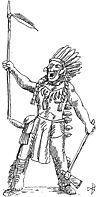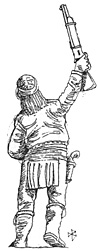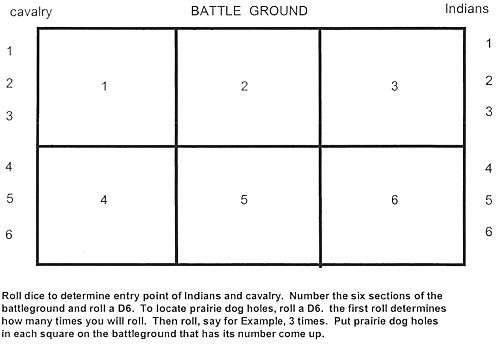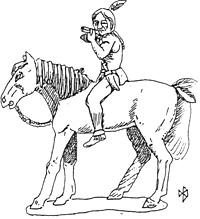 This is an attempt to lay out a scenario for wargaming a famous fight. I will try to make it historically accurate, but that is not easy. There are several books and movies that mostly give mythical versions, while respectable historical sources disagree on some points. Buffalo Bill Cody had a life that seems like somebody made him up. He had two careers: army scout and showman. Sometimes he was both in the same year. He had been chief scout for the Fifth cavalry since 1868, but scouting was off and on work. Scouts were only paid when actively in the field. At other times they had to find other jobs. Sometimes the army hired them for work like stable hand just to keep them nearby if needed. In 1876, the US Army was planning a major campaign, but Buffalo Bill was with his Wild West Show in Delaware. At the final show in Wilmington, Delaware, he announced that he was going to the Indian wars. He was late getting to the regiment and had to meet it in the field.
This is an attempt to lay out a scenario for wargaming a famous fight. I will try to make it historically accurate, but that is not easy. There are several books and movies that mostly give mythical versions, while respectable historical sources disagree on some points. Buffalo Bill Cody had a life that seems like somebody made him up. He had two careers: army scout and showman. Sometimes he was both in the same year. He had been chief scout for the Fifth cavalry since 1868, but scouting was off and on work. Scouts were only paid when actively in the field. At other times they had to find other jobs. Sometimes the army hired them for work like stable hand just to keep them nearby if needed. In 1876, the US Army was planning a major campaign, but Buffalo Bill was with his Wild West Show in Delaware. At the final show in Wilmington, Delaware, he announced that he was going to the Indian wars. He was late getting to the regiment and had to meet it in the field.
While in the field, Buffalo Bill received word of Custer’s death at the Little Bighorn. Many who tell the story of Buffalo Bill’s fight with yellow hair stress revenge for Custer. It seems more like an accidental skirmish than a planned act of vengeance. Cody was scouting for the Fifth cavalry as it patrolled the plains trying to capture or drive Cheyennes before them. They were also planning to link up with an army supply wagon train. The train had dispatched two riders to catch up with the cavalry battalion. These two troopers were spotted by a group of about 40 Cheyennes who began to stalk them. While the Cheyennes were careful to be screened from their intended victims by hills, they were not hidden from a scouting party guided by Cody. Cody was given the honor of leading a party of three scouts and 6 or 7 troopers to cut off the ambush.
Cody was out in the front of his party when he met a group of about 7 Cheyennes with one out front. Both were surprised. The two leaders exchanged shots as soon as they saw each other. Range was about 30 yards. Cody’s shot hit the Indian in the leg, penetrated and killed his horse. The Indian’s shot missed, but Cody’s horse stumbled in a prairie dog hole and Cody was thrown. Now both men were dismounted at a range of perhaps 20 paces. The Indian fired again and missed. Cody was kneeling as the bullet passed him. His second shot hit the Indian and killed him. Cody then collected the Indian’s scalp. All this took just a few seconds. It was the climax of the day.
 The Cheyennes soon saw that there was a sizeable cavalry force coming and left the area. There was no further fighting. The event was briefly noted in Army reports. Later Cody wrote his version, and other witnesses wrote theirs. The myth making started very soon after the fight.
The Cheyennes soon saw that there was a sizeable cavalry force coming and left the area. There was no further fighting. The event was briefly noted in Army reports. Later Cody wrote his version, and other witnesses wrote theirs. The myth making started very soon after the fight.
Let’s emphasize a few details and deny a few of the tall tales. It was a one-on-one fight. No other Cheyennes, scouts, or cavalrymen took part. It was an accidental meeting; there was no challenge or agreement to duel. The two leading riders simply met each other and started shooting. The others were either too far away or too surprised and excited to take part. Note also that the two sides were not lined up facing each other. It was simply a matter of two small parties accidentally meeting.
The location of the fight is subject to some confusion. The Cheyenne use the same word for “hat” and “war bonnet.” Buffalo Bill says the fight happened on War Bonnet Creek, but his most careful biographer says modern maps call the site “Hat Creek.” There is a War Bonnet Creek on modern maps, but it is about forty miles away. Witnesses describe the area as having broken ground, that is, hills cut by stream beds. There is a Frederick Remington painting based on eye witness sources which shows the fight in a small valley with grass. For wargaming purposes, you may want to add a pattern of brown splotches. Remember that Buffalo Bill’s horse stepped in a prairie dog hole. The prairie dog is a rodent about a foot tall. They live in a burrow, a hole about six inches in diameter which is dug down a foot or so then becomes a tunnel under the grass. Each burrow has a mound of fresh dirt piled beside it. Prairie dogs live together in towns. Some towns contain hundreds of burrows. You will need a rule to determine if a horse steps in one of these holes. Was the rider thrown? How did he land? Was the horse’s leg broken? See my suggested rule for prairie dog holes.
Both men were expert shots. Yellow hair’s name indicates that he was a veteran of at least one raid on white people. He had taken the scalp of a woman with yellow hair. The Cheyenne lived by hunting buffalo, so he had experiences shooting buffalo. He was wearing an eagle feather war bonnet that trailed down his back. After the fight, Cody sent it and Yellow hair’s scalp to a friend who displayed them, and both survive. Remington’s painting shows Yellow hair on a white horse, but does not show the war bonnet. The painting shows him with a lever action repeating rifle. My guess is that it was a Henry in .44 caliber.
Buffalo Bill was armed with an 1873 Winchester, probably in .44-.40, a colt revolver, and a sheath knife. He was dressed in buckskins or perhaps in a vaquero sombrero and a red sash. The latter was a show costume. He liked to wear such costumes on the scout so he could say during his shows that he was wearing an actual outfit used in scouting. His horse was probably brown with a blazed face.
Buffalo Bill is so named because he had once made his living killing buffalo to feed a railroad construction crew. He counted that he had killed 4,280. One biographer thinks he underestimated. He killed buffalo by a technique used by Indians. He got the buffalo running, ideally running in a circle. A Buffalo is an agile animal that can run as fast as a good horse. Cody needed a good horse to make this work. The hunter rode up beside the buffalo and shot it. A buffalo is a big target, but hitting a vital spot on a running buffalo while you are riding a galloping horse is skilled work. Buffalo Bill was a good shot. I looked up two rifles, Henry and Winchester ’73 in Gun Digest, 1999. Replicas are still being made. They are both listed as holding twelve shots. Both rifles can be fired very rapidly by a skilled marksman. I have seen a replica Winchester ’73 fired twice with the second shot fired while the empty cartridge from the first shot was flying in the air.
If your game runs longer than just two shots by each man, you may want a rule about the other men joining in. Which side will arrive first? How many? Remember that each party is relatively small. You may want to dice for the weapons the other Indians would have. Some could have repeating rifles, while others might have single shots, and perhaps one or two would be using bow and arrows. On the cavalry side the two other scouts would probably be equipped with repeaters and revolvers. The cavalry officers and troopers would carry Springfield carbines. These are single shot rifles that were breach loading using a trap door action. It is not a rapid firing weapon. The cavalry also used Colt revolvers, “six-shooters,” like those used by the scouts.
At this point we are considering a nice little skirmish involving about fourteen men, all starting on horseback. If you want to make the actions more general, you are on your own.
 Suggestions for Rules
Suggestions for Rules
In the following rules, I made a few assumptions. I assume you already have a set of skirmish rules and will be able to game a shoot-out between two mounted men using rifles. These rules are about solo techniques for adding more men to the fight, deciding where and when they will arrive and how they will be armed. There is also a method for locating prairie dog holes and how they affect the fight. The battlefield drawing included may clarify things. Feel free to ignore them or modify them to your taste. In fighting the skirmish, don’t let history get in the way of a good game. If you take liberties with facts, you won’t be the first.
After the second move, deal out six cards. Let 1-7 of hearts equal Indians arriving on the table and 1-6 of spades equal soldiers or scouts. To determine where they come on the table, number segments of each side 1 to 6, and roll a single D6 for each new combatant. Example: if the deal of 6 turns up a three of hearts and the die roll comes up a 5, the Indian enters action at the section of the Indian side of the table designated “5”. A four of spades and a die roll of 2 means a soldier or scout will enter at the “2” section of the soldier side of the table. For a suggested list of Indians and soldiers, see my table of fighters with the names and equipment for these new combatants. If in any deal of six you turn up a face card of hearts, the Indians realize they are outnumbered and withdraw at once. If you deal a face card of spades, the soldiers realize their patrol is outnumbered by the Indians and withdraw at once. It is possible that both sides will decide to fall back at the same time.
Table of Fighters
Hearts = Indian Warriors. Names are not historical and weapons are my guess. All are veterans.
- Standing Bull. Carries a Henry repeating rifle, knife, and tomahawk.
Rain on Head. Carries a Sharps single shot rifle, Colt revolver (six shot), knife, and tomahawk.
Bear Killer. Carries trap door Springfield carbine captured from 7th cavalry, knife and tomahawk.
Running Wolf. A traditionalist. Carries bow, arrows, lance.
Charging Cow. Carries a muzzle-loading rifle by Hawken, knife, and war club.
Eagle Wing. Carries Winchester repeating rifle, knife, and tomahawk.
Spades = scouts and cavalrymen. Some names are historical and weapons are more or less standard issue.
- Scout Tait. Carries Winchester 1873 repeating rifle, Colt revolver, and knife.
Scout White. Carries Winchester 1873 repeating rifle, Colt revolver, and knife.
Officer Lieutenant Green. Carries Colt revolver and knife.
Sergeant Murphy. Carries trapdoor Springfield carbine, Colt revolver and knife.
Trooper Brown. Carries trapdoor Springfield carbine, Colt revolver and knife.
Trooper Smith. Carries trapdoor Springfield carbine, Colt revolver and knife.
 Prairie Dog Hole
Prairie Dog Hole
Any time a horse moves through a brown spot marking a prairie dog burrow, roll a D6. A roll of 6 indicates the horse stepped into the hole and goes down. Roll a D6 for results for the rider: 1-4 = rider thrown, but still able to act; 5 = rider thrown, but drops weapon, takes one turn to pick it up; 6 = rider stunned out of action for two turns.
Bibliography
Buffalo Bill is the hero of 1700 dime novels, by Don Russell’s count. I use the following books which should be more reliable. Even they don’t agree on the details.
Cody, Colonel W.F. Buffalo Bill’s Life and Story: An Autobiography. (1920, reprinted in 1998).
Russell, Don. The Lives and Legends of Buffalo Bill. (1960).
Wheeler, Keith. The Scouts. (1978).
Yost, Nellie Irene Snyder. Buffalo Bill: His family, friends, Fame and Failures. (1979).
The Winchester ’73 material is based on a telephone interview with John Scott. We have a photograph of the shells in the air as the shot is fired.
Back to Table of Contents -- Lone Warrior # 149
Back to Lone Warrior List of Issues
Back to MagWeb Magazine List
© Copyright 2005 by Solo Wargamers Association.
This article appears in MagWeb.com (Magazine Web) on the Internet World Wide Web.
Other articles from military history and related magazines are available at http://www.magweb.com
